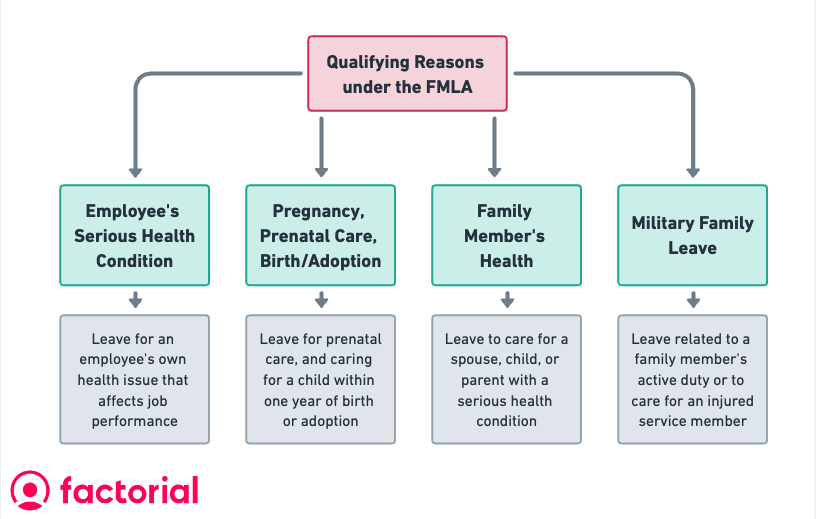The Family and Medical Leave Act (FMLA) is designed to aid employees navigating significant personal or family health matters, without the risk of losing their employment.
With this article you will be able to understand the eligibility criteria, application process, and the protections it affords to employees, thus highlighting its significance in the contemporary work environment.
TABLE OF CONTENTS
- What is Family and Medical Leave Act (FMLA)?
- FMLA: Eligibility Criteria
- Qualifying Reasons under the FMLA
- Duration and Types of Family and Medical Leaves
- Employee Rights and Employer Obligations Under the FMLA Leave
- How To Request FMLA Leave
- Official Resources about FMLA
- FMLA per State
- FAQ About Family And Medical Leave
- Effortlessly Track Employee Time Off With This HR Software ✅
What is Family and Medical Leave Act (FMLA)?
As a landmark piece of legislation in the United States, the Family and Medical Leave Act (FMLA) was enacted in 1993. In the beginning, it was recognized that workers facing health crises, without losing their jobs, needed help.
In essence, FMLA allows employees 12 weeks of unpaid, job-protected leave per year while maintaining their health insurance coverage. All government agencies, elementary and secondary schools, and companies with 50 or more employees are covered by this law. FMLA covers a wide range of situations, including illness, childbirth, adoption, and military family circumstances.
FMLA: Eligibility Criteria
The Family and Medical Leave Act (FMLA) sets specific criteria to determine who is covered under its provisions.

- Employer Eligibility: FMLA applies to private-sector employers with 50 or more employees within a 75-mile radius, for at least 20 workweeks in the current or preceding calendar year. It also encompasses all public agencies, including local, state, and federal employers, and public and private elementary and secondary schools, regardless of the number of employees.
- Employee Eligibility: To be eligible for FMLA leave, an employee must have worked for a covered employer for at least 12 months (not necessarily consecutive). They must have worked a minimum of 1,250 hours during the 12 months prior to the start of the FMLA leave. The employee should be working at a location where the employer has at least 50 employees within a 75-mile radius.
Qualifying Reasons under the FMLA
Under the Family and Medical Leave Act (FMLA), employees are entitled to take leave for several significant reasons:

- Personal: Leave for an employee’s own serious health issue
- Family Member’s Serious Health Conditions: This includes to care for a spouse, child, or parent suffering from a serious health condition.
- Birth, Adoption, or Foster Care Placement of a Child: FMLA allows parents to take leave for the birth of a child, as well as for the adoption or foster care placement of a child, providing time for bonding and care.
- Military-Related Exigencies and Caregiver Leave: Employees may take leave for reasons related to a family member’s military service, including exigencies arising from a family member’s deployment. FMLA also provides for a longer leave (up to 26 weeks) to care for a family member who is a service member with a serious injury or illness.
Duration and Types of Family and Medical Leaves
Duration of leaves under the Family and Medical Leave Act (FMLA)
- Maximum Duration of FMLA Leave: Employees are entitled to a maximum of 12 weeks of unpaid leave within a 12-month period. In the case of military caregiver leave, this duration extends to 26 weeks.
Types of Family and Medical Leaves in New Jersey
- Continuous Leave: This involves taking a continuous, uninterrupted leave period.
- Intermittent Leave: This type of leave allows employees to take FMLA leave in separate blocks of time due to a single qualifying reason.
- Reduced Schedule Leave: This allows an employee to reduce their working hours, either daily or weekly, for a period of time due to a qualifying reason.
Employee Rights and Employer Obligations Under the FMLA Leave

Job Security
Employees are guaranteed the right to return to the same or an equivalent position.
This protection ensures job security, even after an extended period away for qualifying reasons.
Health Insurance Maintenance
Employers must maintain the employee’s health insurance under the same terms and conditions as if they had not taken leave.
Employees continue to be responsible for their portion of health insurance premiums.
Protection of Employee Benefits
Employee’s benefits are maintained as if the worker is actively working.
Employer’s Role in Granting Leave and Maintaining Compliance
Employers are required to grant leave to eligible employees for qualifying reasons under the FMLA.
They must also keep accurate records and comply with all aspects of the FMLA, including not interfering with, restraining, or denying the exercise of FMLA rights.
Employers are prohibited from retaliating against employees for taking FMLA leave.
How To Request FMLA Leave
Step-by-Step Guide on How Employees Can Request FMLA Leave
- Determine Eligibility: You must work at a location with 50 or more employees within a 75-mile radius and be employed for at least 12 months by a covered employer.
- Understand the Reason for Leave: Determine your FMLA qualifying reason, such as personal health issues, family member care, birth or adoption of a child, or military exigencies.
- Notify Your Employer: Notify your employer in writing or verbally of your need for FMLA leave. While immediate notice is not always possible, FMLA generally requires 30 days’ advance notice.
- Submit Required Forms and Documentation: Complete any FMLA leave request forms provided by your employer. Provide medical certification or other required documentation to support your leave request, such as a doctor’s note or military orders, if applicable.
- Await Employer Response: After submitting your request, your employer must respond within five business days, notifying you of your eligibility and detailing any additional information required.
- Coordinate Leave Details: Discuss with your employer the specifics of your leave, such as the start date, duration, and any potential need for intermittent leave or a reduced schedule.
- Understand Your Rights and Responsibilities: Review the rights and responsibilities under FMLA, including job protection, health insurance continuation, and any obligations you have during your leave.
Documentation and Notice Requirements
- Medical Certification: If you need leave due to serious medical conditions (personal or family), provide a medical certificate. The certification should include the date the condition began, its expected duration, and relevant medical facts.
- Advance Notice: In case of foreseeable leave, such as childbirth or planned medical treatment, provide at least 30 days’ notice.
- Periodic Updates: Keep your employer informed about your status and intent to return to work, especially if the leave duration changes.
- Fitness-for-Duty Certification: Provide your employer with a fitness-for-duty certification before returning to work from serious health leave.
FAQ about Family and Medical Leave
1. What is the Family and Medical Leave Act (FMLA)?
FMLA is a U.S. federal law that allows eligible employees of covered employers to take unpaid, job-protected leave for specified family and medical reasons while maintaining group health insurance coverage.
2. Who is eligible for FMLA leave?
Employees are eligible if they have worked for their employer for at least 12 months, have 1,250 hours of service in the 12 months prior to the start of leave, and work at a location where the employer has 50 or more employees within 75 miles.
3. What reasons qualify for FMLA leave?
Qualifying reasons include the birth and care of a newborn child, adoption or foster care placement of a child, caring for an immediate family member with a serious health condition, or a personal serious health condition that makes the employee unable to perform their job.
4. How much leave can I take under FMLA?
Eligible employees can take up to 12 weeks of leave in a 12-month period for most FMLA reasons. For military caregiver leave, eligible employees can take up to 26 weeks of leave in a single 12-month period.
5. Is FMLA leave paid or unpaid?
FMLA leave is generally unpaid. However, employees can choose or employers may require the use of accrued paid leave, such as vacation or sick leave, for some or all of the FMLA leave period.
Does FMLA protect my job?
Yes, FMLA provides job protection. Upon return from FMLA leave, employees must be restored to their original or equivalent positions with equivalent pay, benefits, and other employment terms.
How do I request FMLA leave?
Employees should notify their employer of their need for FMLA leave as soon as possible. For foreseeable leaves, employees should provide a 30-day notice.
Can my employer deny my FMLA request?
An employer cannot deny a legitimate FMLA request if the employee is eligible and the reason for leave qualifies under the FMLA. However, employees may need to provide sufficient documentation, such as a medical certification, to support their request.
Do I need to provide medical proof for FMLA leave?
For leaves due to serious health conditions, employers can require a medical certification from a healthcare provider.
Can I take FMLA leave intermittently?
Yes, FMLA leave can be taken intermittently or on a reduced schedule when medically necessary.



